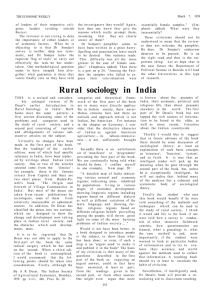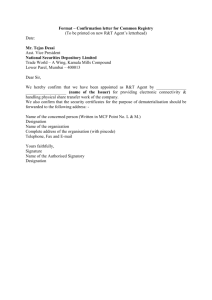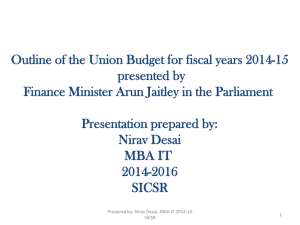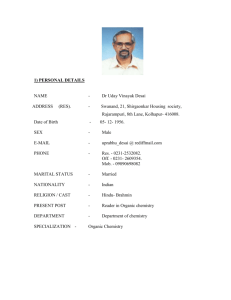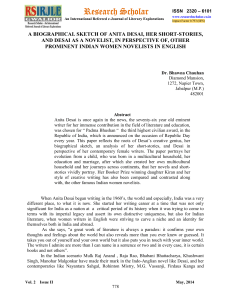The Thematic Study of Anita Desai
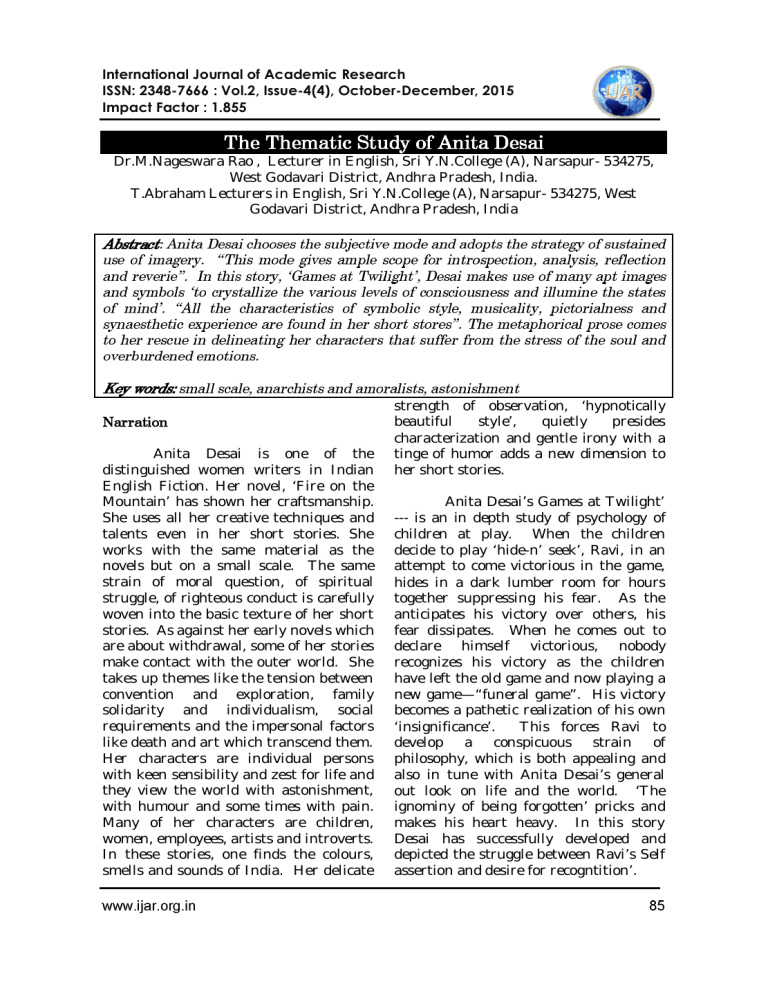
International Journal of Academic Research
ISSN: 2348-7666 : Vol.2, Issue-4(4), October-December, 2015
Impact Factor : 1.855
Dr.M.Nageswara Rao , Lecturer in English, Sri Y.N.College (A), Narsapur- 534275,
West Godavari District, Andhra Pradesh, India.
T.Abraham Lecturers in English, Sri Y.N.College (A), Narsapur- 534275, West
Godavari District, Andhra Pradesh, India
Anita Desai is one of the distinguished women writers in Indian
English Fiction. Her novel, ‘Fire on the
Mountain’ has shown her craftsmanship.
She uses all her creative techniques and talents even in her short stories. She works with the same material as the novels but on a small scale. The same strain of moral question, of spiritual struggle, of righteous conduct is carefully woven into the basic texture of her short stories. As against her early novels which are about withdrawal, some of her stories make contact with the outer world. She takes up themes like the tension between convention and exploration, family solidarity and individualism, social requirements and the impersonal factors like death and art which transcend them.
Her characters are individual persons with keen sensibility and zest for life and they view the world with astonishment, with humour and some times with pain.
Many of her characters are children, women, employees, artists and introverts.
In these stories, one finds the colours, smells and sounds of India. Her delicate strength of observation, ‘hypnotically beautiful style’, quietly presides characterization and gentle irony with a tinge of humor adds a new dimension to her short stories. declare develop
Anita Desai’s Games at Twilight’
--- is an in depth study of psychology of children at play. When the children decide to play ‘hide-n’ seek’, Ravi, in an attempt to come victorious in the game, hides in a dark lumber room for hours together suppressing his fear. As the anticipates his victory over others, his fear dissipates. When he comes out to himself a victorious, conspicuous nobody recognizes his victory as the children have left the old game and now playing a new game—“funeral game”. His victory becomes a pathetic realization of his own
‘insignificance’. This forces Ravi to strain assertion and desire for recogntition’. of philosophy, which is both appealing and also in tune with Anita Desai’s general out look on life and the world. ‘The ignominy of being forgotten’ pricks and makes his heart heavy. In this story
Desai has successfully developed and depicted the struggle between Ravi’s Self
International Journal of Academic Research
ISSN: 2348-7666 : Vol.2, Issue-4(4), October-December, 2015
Impact Factor : 1.855
Anita Desai’s, the inner climate, the climate of sensibility, is more compelling than the visible action. As
Iyengar puts it “Her forte……… is the exploration of sensibility the particular kind of modern Indian sensibility that is ill at ease among the barbarians and the philistines, the anarchists and amoralists”. Desai focuses her searching lens on the visible bit of reality which is like the tip of a submerged ice-burg. The purpose of her writing is to explore this submerged truth and the does it through the exploration of the psyche of her characters. In the sotry ‘Games at
Twilight, she creates an intense moment of psychological struggle in the mind of
Ravi to explore deep into it. She is interested in “delving deeper and deeper into a character, a situation, or a scene rather than going round about it”.
In the story “Studies in the
Park”, we find another kind of withdrawal, withdrawal from material pursuits, from participation in the rat race. Suno, in a bid to get first in his examination, finds a suitable place in a park and sticks to his books. But, books are like parasites they suck him dry’.
Under the overwhelming pressure of study, he gradually loses his ability to function suitably, both physically and pshychologically. Desai describes Suno’s state of hopelessness. “ I lay sluggishly on a heap of waste paper under my tree and read without seeing and slept without sleeping……. I felt as if we were all dying in the park, that when we entered the examination hall it would be to be declared officially dead…. I don’t work myself any more—I mean physically, my body no longer functioned.
(P.29).
Anita Desai chooses the subjective mode and adopts the strategy of sustained use of imagery. “This mode gives ample scope for introspection, analysis, reflection and reverie”. In this story, ‘Games at Twilight’, Desai makes use of many apt images and symbols ‘ to crystallize the various levels of consciousness and illumine the states of mind’. “All the characteristics of symbolic style, musicality, pictorialness and synaesthetic experience are found in her short stores”. The metaphorical prose comes to her rescue in delineating her characters who suffer from the stress of the soul and overburdened emotions.
Desai takes up her images from a large variety of sources depending on the aptness of the situation. “Her most important source is nature and she has a whole range of images drawn from vegetable and plant life, birds, animals and other natural phenomena”.
At this point in the story, Suno sees a young beautiful woman on a bench, in the park, her head lying on the lap of a man, who is caressing her face.
We find this same image in her novel
‘Where shall we GO this Summer’ Where
Sita recollects this scene in the park as the only happy memory she has. This vision of tender relationship between the couple creates an emotionally moving moment. Suno’s extreme reaction to tension is both distressing and horrifying.
He develops an apathy towards studies.
He feels that it is a useless burden in the face of love and kindness. Life becomes for him a search and is no longer a race’.
Here Desai postulates her vision or outlook life through Suno on a micro plane – Her overall vision of life is not merely to feel helplessness in the face of grim realities of life, but to face them boldly. This story also depicts a universal theme parent’s ambition and society’s
International Journal of Academic Research
ISSN: 2348-7666 : Vol.2, Issue-4(4), October-December, 2015
Impact Factor : 1.855 competitiveness which sandwitch students like Suno. Some of the well written lines in this story run like poetry.
They are very crisp like the delicate strokes of a sculptor or finishing touches of a great painter.
In the story ‘Sale’, as in the
‘Studies in the park’, proving one’s worth is the central struggles. A poor gifted artist, who is compelled to sell his paintings to support his family finds it difficult to survive in a competitive and sensitive environment. A party of prospective buyers encourage him with a hyprocritical show of friendship and praise his paintings. They bargain many pieces of art but when the poor artist, who is badly in need of money, asks for some advance, they show their empty pockets. This customers’ callous reaction produces that intense moment in which the story is tied together. The reader is drawn into sympathy with the artist’s hopeless position. In this story Desai gives no names to her characters as if to present the universal predicament of the artists and snobbery of the artless and heartless customers. Through this story
Desai expresses her deep concern over the declining aesthetic taste of the people which is wholly responsible for the plight of the artists.
The stories like ‘A Devoted Son’,
‘Surface Textures’ , The Accompanist’,
‘Pigeons at Day Break’ , ‘The Farewell
Party’ , and scholar and gypsy though skillfully written, containing excellent imagery and unusual Characterization, some of the stories fell short in their emotional power. Some lack unified structure of a well developed conflict.
The short story “A devoted son” is based on the generation gap and attitudinal clashes between a doctor son and his aged father. Dr.Rakesh, a devoted son fulfills the dreams of his parents. He gives his ageing father the full benefits of filial duty and medical science. He prescribes many medicines, pills and powders and a restricted diet to his father. But the father is impatient to give up his old food habits. He complains of his son’s callous behaviour to his neighbour, Bhatia. The old man finds life a chore and prefers death to such a restricted diet. This story is both touching and comic in the insight it reveals of human psychology of the old man and dutiful doctor son. The old man is sentimental whereas the son is very rational. Though the story has ‘no unity of time’, the singleness of effect is achieved by Desai by concentrating on certain traits in her principal characters.
Some critics find fault with Desai for shifting of focus from Rakesh to Varma.
‘Surface Textures’ is an indepth study of a person who shirks his immediate responsibility and is indifferent to his normal duties. Harish, a poor clerk in a supply office, becomes intensely preoccupied with the textures of objects. He finds himself incapable of enduring the burden of his family any longer. He wants to become a sadhu as he considers the life of a sanyasi is far better than that of a poor clerk. As he is an escapist, he brings discredit to the life of a saint. His ‘surface texture’ of incompetence and lazyness, are now equally impending his new life of a
Sadhu. Here Anita Desai attacks the evasiveness and irresponsibility of people like Harish. It is also a satire on pseudo sadhus. Desai starts the story from
Sheila’s point of view and then switches over to Harish point of view and this lack of unity in its structure weakens the potential power of the story.
International Journal of Academic Research
ISSN: 2348-7666 : Vol.2, Issue-4(4), October-December, 2015
Impact Factor : 1.855
In ‘The Accompanist’, Desai delineates the emotional state of a
Tampura player Mr.Misra. The company of ustad Rahim Khan makes a street urchin an accompanist. But once, he recollects and confesses, how his calm has been destroyed, his devotion shaken when his child-hood friends had mocked at him. But he is convinced after some soul-searching that he can never become
‘Ustad’ in his own right and feels ‘Does a mortal refused God”. This story deals with the life of those devoted characters who feel happy to pursue the path of virtue, righteousness and commitment.
This story gives the germinal idea of the theme to Anita Desai’s novel ‘In
Custody’. One of the interesting features of this story is the use of first person narrative.
In ‘Pigeons at Day-break’, Desai takes up the same theme as in ‘Devoted
Son The theme of old age and the unreasonable claims of a patient’.
Asthamatic Bose always feels uneasy about something while his generous and devoted but too talkative wife, though irritates Bose with her talk, does all her best to provide some comfort to her husband. The news about supposed power cut seems to cut the very chords of life of Bose. This is a psychological story dealing with the supposed problems of an asthamatic patient like old Bose. The flight of pigeons at day break symbolize peace and liberation. It is at day break
Bose gets a temporary respite from the night’s suffocating air and physical pain.
Here Desai tries to depict the dutifulness of a devoted wife.
In ‘The Farwell Party’, Desai presents both the hollowness and want of social life. The ‘Cinderella like friendliness’ that pervades in the society is well revealed in the party. Through this story, Desai mocks at the snobbery of high brows. In the story ‘The Private
Tution by Mr.Bose’, Desai presents the hardships of a middle class private teacher. It is a punishment to a teacher to be asked to teach an unwilling learner.
Mr. Bose in the midst of domestic chorus tries his best to teach Sanskrit to Pritam, who coughs imitating his favourite screen actors and shows little interest in studies.
He is rather forced to read and teach
Bengali Poetry to Upaneet, a girl of fashion, who comes more for mischief and mockery than to learn anything. Her presence irritates the house-wife as
Upaneet’s cunning glances are more on the teacher than on the book. Her presence seems to spoil the harmony of the home. Nagging Mrs. Bose lets her complaining child cry all the while.
When Bose asks her to keep the child quite, she finds a tough time to control the child. There is an exchange of heated dialogues but at the end of the day they have to come to terms with each other as their’s is a ‘lovers’ quarrel’. It is a psychological short story which deals with psychology of a poor teacher engaged in private tuitions. In the story
‘Pineapple Cake’ Desai presents glimpse of westernized parties and pomp and show associated with them. Mrs.
Fernandez, who is a worldly-wise lady having a great appetite, takes her son to a wedding party. She provides her son victor with a pineapple cake on the condition that he should not misbehave there. But at the time of wedding, a gentleman dies. This shocks sensitive
Victor and he cannot enjoy the Pineapple cake. But his mother eats a lot. She is not at all sorry for the death of a man.
The son finds his mother’s strange conduct at the party quite inconsistent with her utterances.
International Journal of Academic Research
ISSN: 2348-7666 : Vol.2, Issue-4(4), October-December, 2015
Impact Factor : 1.855
‘Scholar and Gypsy’ is a story about the clash of cultures, about redefinitions of meanings in life. It presents an American Couple’s reaction to their experiences in India. David in his scholastic pursuits dislikes gypsy ways of pat. Pat dislikes the urban social life of Bombay as she considers it to be primitive. As they move from the city to hills David feels estranged from her. Pat prefers to join Hippies in their search for
Nirvana. But David returns to Delhi and his thesis. The psychological revelation and analysis in which Anita Desai shows a keen interest gives a new dimension and direction to the themes of her stories as well as novels. In the story, each event acquires importance and it directly or indirectly debunks the protagonists of their old selves or outerposes and moves them towards some kind of self revelation and assessment. “It is this position vis-àvis their former selves which changes”. In this story many of the details used by
Anita Desai to create the characters of
David and Pat are well selected. She paints an exceptionally vivid back-drop for their actions. But Desai fails here because of her unconvincing dialogue-as she uses British-English over tones and
Victorian attitudes in the portrayal of an
American couple. attain the desired finale of acceptance”.
In spite of some limitations, Anita Desai has got great potential as a short story writer, Her optimism is well revealed in almost all her short stories. Her ‘Sita’s character aptly suggests what Anita wants to convey by natural living. “Sita compromises between ‘What is’ and
‘What ought to be’. The struggle before us and the efforts which we should harness to surmount the struggle”.
Anita Desai brings out different problematic themes like psychological, philosophical, cultural, sociological etc.,
These issues are conspicuous in society of all ages. Thus she tries to bring change in society by selecting these themes in her works.
1.
2.
Jasbir Jain, Stairs Of The Attic, The
Novels Of Anita Desai, Jaipur,
Printwell Pubishers, 1987, P.14.
K.R.Srinivas Iyengar, Indian Writing
In English, New Delhi, Sterling
Publishers, Pvt. Ltd., 1985, P.464,
745.
3.
S.D.Sarma ‘Anita Desai’ studies in contemporary Indian English Short story Ed AN Dwivedi – Delhi, BR
Publishing Corporation 1991, p.42
4.
S.Indira, Anita Desai as an Artist,
New Delhi, Creativ1994, P.4, 7 In her short stories her style shows to even more advantage than in the novels. The best ingredients of her style in short stories are childhood memories and the haunting feelings surging out of a romantic heart. In
Iyengar’s words “As we remain mesmorised by Anita Desai’s verbal artistry and her uncanny evocation of atmosphere, her tale unfalteringly glides by and we force a rendition of the veil of happening or a memory to gain entry into the realm of personal experience and
